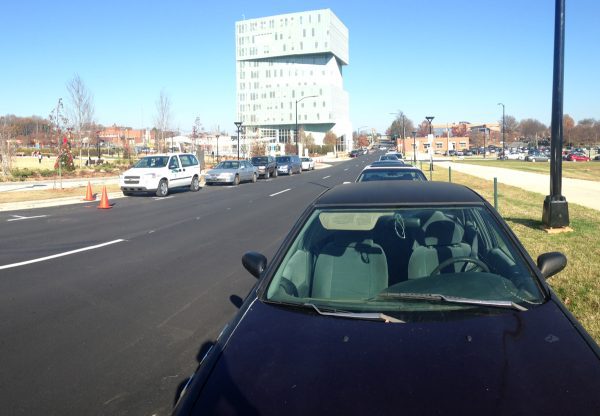Dear City Council: Where are bike lanes to our new uptown park?

An open letter to Charlotte City Council members:
Today we are unveiling the new First Ward Park, which is extremely positive for our community. With this new park and the developments that will follow, we have a tremendous opportunity to avoid mistakes we have made in the past with respect to providing safe infrastructure for cyclists and pedestrians as well as motorists.
However, already, we have missed an opportunity. The section of North Brevard Street along the east side of the new First Ward Park has been re-constructed with bulb-out street parking on both sides— and no bike lanes. By doing this, we have sent a message to the community that the ability to drive to the park is more important than the ability to visit it by bicycle. For an urban park, in one of the densest parts our city, this is the wrong message.
When reading today’s Charlotte Agenda article about all the planned developments in the area, I learned that the city is paying developer Daniel Levine nearly $30 million in the form of a grant for building a massive parking deck right next to the Blue Line Extension light rail. Again, this is sending the wrong message. It is telling the public that while we have invested nearly $1.2 billion in public funds to build a new light rail line that will, literally, stop in the park, we want to make it possible for everyone to drive to this area as well. How does this grant support our investment in the Blue Line Extension and encourage residents to choose transit over driving, which should be a major city priority given our projected population growth and already congested roads?
In all the renderings shown in the article, depicting the development planned for this area, not a single bike lane is visible. In fact, cyclists are shown riding on the sidewalk—unsafe for pedestrians and cyclists (not to mention illegal on many Center City streets nearby). However, more bulb-out parking is shown, despite Levine promising at least 1,335 public parking spaces as part of the grant agreement. Surely the public spaces in this area, the city streets, can be dedicated for public use rather than private parking?
We have an incredible opportunity, with this development, to build infrastructure for cyclists as well as motorists and pedestrians, but so far we have missed this opportunity by using valuable public space to provide temporary storage (i.e. parking) for privately owned cars.
Let’s seize this unique opportunity to build this part of our city in a way that encourages and supports walking, biking, and riding transit, rather than continuing to devote so many public dollars to ensuring that everyone can easily get around by car. Auto-oriented development should be in our past, not our present, and certainly not in one of the most urban parts of our city.
I look to you to ensure that we will follow our own Urban Street Design Guidelines, which Charlotte City Council passed in 2007 to “create streets that provide capacity and mobility for motorists, while also being safer and more comfortable for pedestrians, cyclists, and neighborhood residents.”
I look forward to your leadership on this issue for the benefit of all current and future Charlotteans.
Shannon Binns is founder and executive director of Sustain Charlotte, a nonprofit group that aims to educate, engage and unite residents to solve Charlotte’s sustainability challenges.
Opinions in this article are those of the author and not necessarily of the UNC Charlotte Urban Institute or the University of North Carolina at Charlotte.
Shannon Binns